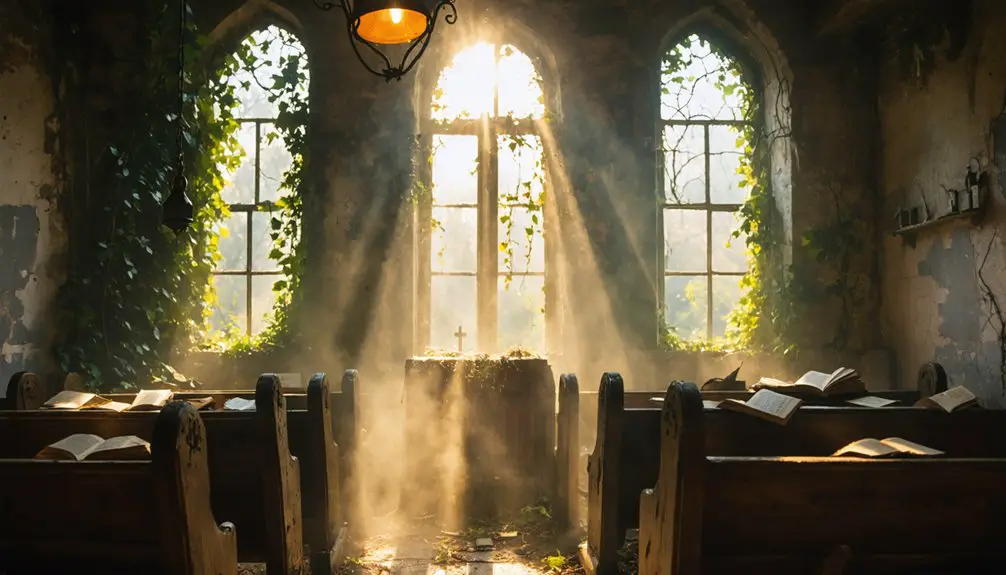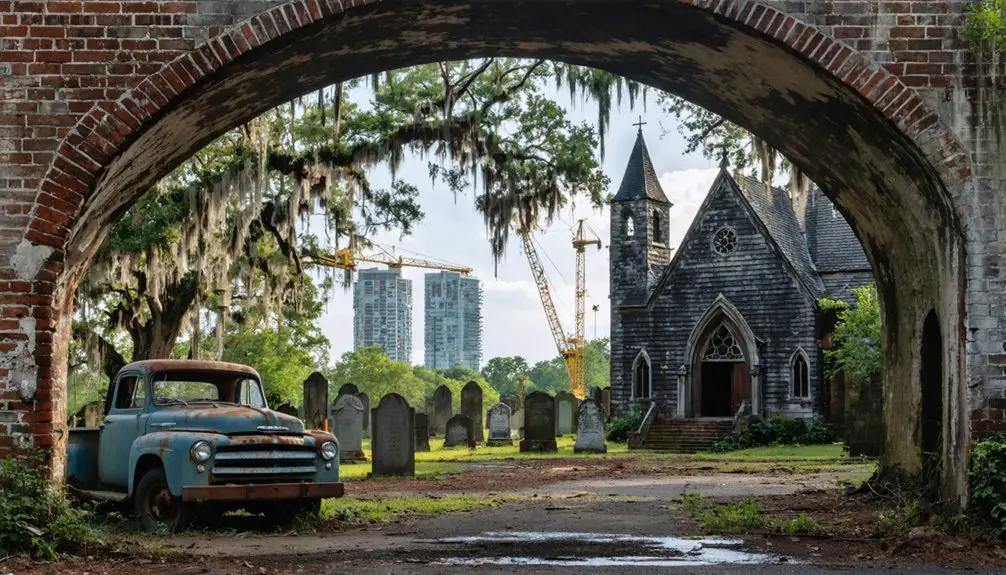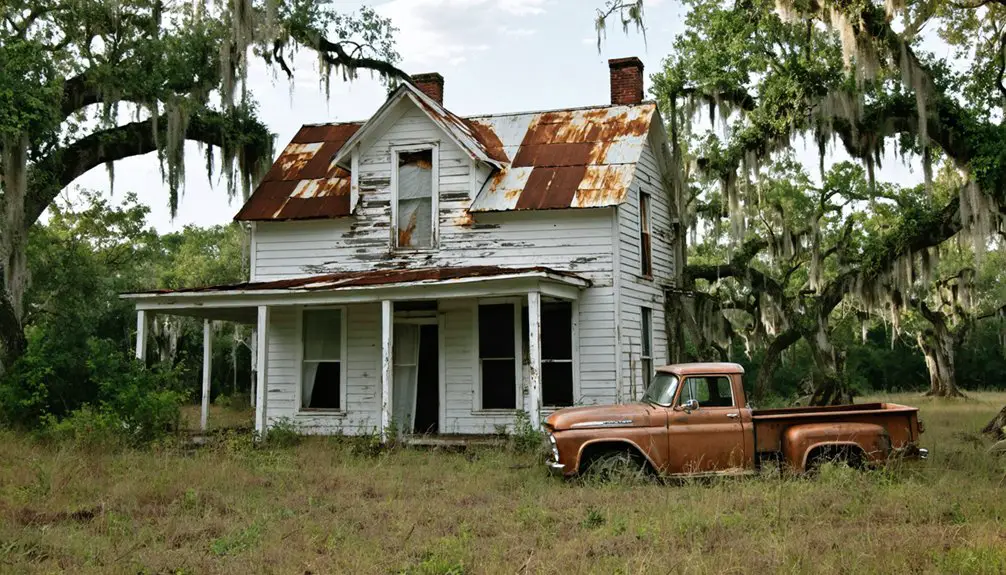You’ll find Montague’s ghostly traces near Highway 464 in Marion County, Florida, where this historic Black settlement flourished in the late 1800s. At its peak, about 100 residents built a tight-knit farming community with a church, mission, and school. Today, only moss-covered graves and oral histories remain to tell the story of this vanished town, which faced agricultural hardships and a devastating 1928 tornado. The buried footprints of Montague’s determined pioneers hold fascinating secrets beneath modern suburban developments.
Key Takeaways
- Montague was a predominantly Black settlement near Highway 464 in Florida that emerged in the late 1800s and peaked at 100 residents.
- The community featured a church, mission, and school, focusing on farming while building cultural resilience against systemic barriers.
- Natural disasters, including a devastating 1928 tornado and crop freezes, contributed significantly to the town’s eventual abandonment.
- Only two moss-covered graves and an old hand pump well remain as physical evidence of this once-thriving community.
- Modern suburban development has completely transformed the original settlement, though its legacy persists through oral histories and archaeological findings.
Unearthing Montague’s Hidden Past
While many Florida ghost towns leave behind substantial ruins, Montague’s legacy persists mainly through its cemeteries, oral histories, and subtle traces in the landscape.
You’ll find its historical significance deeply rooted in its unique Shakespearean naming alongside sister town Capulet, though the reasoning behind these literary names remains a mystery even to family descendants. Located just a mile apart, these two settlements developed distinct yet interconnected communities.
The chiefly Black settlement’s cultural connections live on through restored graves, including those of Rev. John Brooke Pinney and his wife, while archaeological digs continue to reveal fragments of daily life. Initial excavations in the 1930s revealed thirty-one dwellings that provided crucial insights into the settlement’s layout and daily life.
Local historians and those with personal ties, like Montague Tallant, maintain active interest in the site’s material culture, ensuring this settlement’s story isn’t lost to time despite limited physical remains.
The Rise and Fall of a Florida Settlement
As Marion County, Florida expanded in the late 1800s, the mainly Black settlement of Montague emerged near what’s now Highway 464, named by S.S. Savage. At its peak, you’d have found about 100 residents building a vibrant community centered around farming, faith, and cultural resilience. Like many Florida settlements, Montague faced severe crop freezes that impacted local agriculture.
The town’s infrastructure included a church, mission, and school, while the neighboring settlement of Capulet housed their post office. Despite creating a strong social hub for African American settlers, Montague faced mounting agricultural challenges. The influential Reverend John Brooke Pinney established a mission on 240 acres.
The devastating 1928 tornado, combined with limited market access and urban migration, led to the community’s gradual decline. Today, while no buildings remain standing, you’ll find the town’s legacy preserved in cemetery sites and local histories, evidence of Black pioneers’ determination in segregated Florida.
Life in Early Marion County
Following the establishment of Marion County in 1844, you’d have found a diverse landscape of settlers, Native Americans, and military personnel centered around Fort King, the county’s first administrative hub.
Early settlers, many from South Carolina, carved out homesteads near rivers and springs, relying on steamboats for transportation. You would’ve witnessed community governance evolve from humble log buildings at Fort King to more permanent structures, as Sheriff William Strifel maintained order in that first pivotal year. Edmund Davis Howse became the county’s first Sheriff under statehood in 1845.
The Timucuan Indians, who were the area’s earliest known inhabitants, had largely disappeared by this time due to European diseases and conflicts.
If you’d ventured through the county then, you’d have discovered a region transforming through citrus cultivation and emerging settlements.
Despite swampy terrain and poor roads, the area’s clear springs and strategic location drew persistent pioneers who’d lay the groundwork for future railroad development and town expansion in the 1880s.
Surviving Traces and Sacred Ground
Today in Montague, you’ll find just two moss-covered graves marking what remains of this vanished Florida town. The sacred burial ground stands as the sole tangible evidence of a community that once thrived here, now hidden beneath suburban developments and concrete.
Like many ghost town landmarks, these remnants serve as a powerful reminder of Florida’s complex history of boom-and-bust settlement patterns.
You’ll notice the landscape has transformed dramatically – quiet roads wind through pine trees, and modern homes with manicured lawns have replaced the original structures.
While the town’s physical presence has faded, its memory preservation continues through these weathered gravestones and the natural elements surrounding them. The grave significance extends beyond mere markers; they’re portals to the past, inviting quiet reflection on the spiritual and cultural legacy of early Marion County settlers.
The land still whispers its history through pine needles and moss-draped stones. Near Cedar Grove, the old hand pump well remains as a lasting connection to the daily routines of past residents.
The Black Community Legacy
While the physical traces of Montague have largely vanished, the legacy of its Black community stands as a tribute to post-Civil War resilience and determination.
Through Rev. Pinney’s church and school, residents built lasting social bonds that strengthened their collective identity and preserved cultural traditions. You’ll find their historical significance woven into the economic fabric of early Florida, where they contributed to thriving citrus, timber, and railroad industries despite systemic barriers. Much like in Royal, Florida, local families have maintained control of their ancestral lands through determination and a deep commitment to their heritage.
Like many Black towns in Florida, Montague’s community faced displacement and erasure through racial violence and exclusionary practices. This mirrors the tragic events of Rosewood in 1923, when an entire Black community was violently destroyed and forced to flee their homes.
Yet their story of community resilience endures through the efforts of activists and historians fighting to protect these sacred spaces, ensuring future generations remember the hopes, struggles, and achievements of Montague’s Black pioneers.
Tales of Two Ghost Towns
You’ll find Montague’s forgotten story intertwined with its sister town Capulet, both named by S.S. Savage in what appears to be a literary nod to Shakespeare’s famous feuding families.
While Montague relied on farming and left behind only two marked graves near modern Highway 464, Capulet’s legacy lives on through its maintained cemetery and the legendary tale of its church being lifted by a 1928 tornado.
These sister communities, though lacking physical remnants beyond their burial grounds, represent a fascinating chapter in Florida’s rural history where Black settlement, cultural naming traditions, and local folklore merged into a unique heritage story.
Montague’s Sister Town Capulet
A quiet ghost town nestled in northern Marion County, Capulet shared an intimate connection with its sister settlement Montague through more than just their Shakespearean names.
Named by S.S. Savage, Capulet history centers around its church, school, and enduring cemetery. You’ll find the Capulet cemetery near State Road 464 and Baseline Road, where nature slowly reclaims this cultural touchstone of the past.
- The 1928 tornado famously displaced Capulet’s church building while mysteriously leaving its interior intact.
- Though lacking its own post office, Capulet’s residents shared resources and community life with nearby Montague.
- The town’s legacy lives on through local folklore and the stories of descendants who still visit the cemetery.
Today, you won’t find Capulet on any modern maps, but its whispered history echoes through the pine forests that once sheltered this vanished community.
Lost Communities’ Parallel Stories
Despite their Shakespearean namesakes, Montague and Capulet developed as peaceful sister settlements rather than rival towns in northern Marion County, Florida.
You’ll find their community connections ran deep – Capulet even relied on Montague’s post office, while both towns maintained small churches and schools that served their distinct populations.
Montague’s identity as a mainly Black settlement showcases the cultural resilience of its roughly 100 residents, who built meaningful lives despite the era’s challenges.
While both towns faded quietly into history without dramatic ruins, their stories live on through different means: Montague through oral histories and subtle landscape clues, Capulet through its cemetery and the legendary tale of its tornado-moved church.
Their parallel decline left only graves and memories as evidence to their once-vibrant communities.
Preserving Oral History

You’ll find invaluable historical truth in the spoken memories of Montague’s community elders, who share firsthand accounts of this mainly Black settlement’s past.
Through recorded interviews with figures like Sybil Browne Bray and the Savage family, local stories paint a vivid picture of life in this Florida ghost town where written records are scarce.
These family memories, passed down through generations, serve as essential threads in weaving together Montague’s cultural heritage, from the naming of the town to the dramatic 1928 tornado that struck nearby Capulet’s church.
Community Elder Interviews
Through meticulous oral history interviews, community elders have become the essential guardians of Montague’s historical legacy. Their elder narratives reveal intimate details about daily life in this mainly Black settlement, from church gatherings to school activities.
You’ll find rich community perspectives about influential figures like Rev. John Brooke Pinney, who founded a local school and served until 1882. Multiple interview sessions help build trust, allowing elders to share deeper insights about Montague’s cultural heritage.
- Audio and video recordings capture authentic voices, preserving tone and non-verbal elements
- Stories focus on personal experiences of landmarks, social life, and notable residents
- Elders serve as custodians of intangible heritage as physical traces fade away
Local Stories Matter
While official records tell only part of Montague’s story, the town’s rich oral history traditions reveal intimate details of life in this historic Black settlement. Through community storytelling, you’ll discover personal narratives that fill essential gaps where physical structures no longer exist.
These stories capture the lived experiences often excluded from formal histories, particularly regarding the Black community’s heritage and social fabric. Narrative preservation becomes especially important as elder generations age and descendants disperse due to migration and urban development.
You’ll find that local folklore, like tales of the 1928 tornado that scattered church pews across fields, adds depth to Montague’s legacy. By collecting written anecdotes, letters, and diaries, you’re helping preserve these precious stories that complement limited archival materials with authentic, personal perspectives.
Recording Family Memories
Recording cherished family memories requires both technical precision and cultural sensitivity to properly preserve Montague’s oral histories for future generations.
When you’re capturing family storytelling sessions, you’ll want to use high-quality digital recording equipment at 16-bit, 44.1 kHz WAV format for ideal sound clarity. Store your recordings immediately on multiple devices and maintain at least four backup copies in separate locations for memory preservation.
- Create detailed, time-stamped transcripts of family stories and link them with relevant photos and documents.
- Store original recordings in temperature-controlled environments between 50-70°F with 40-50% humidity.
- Use archival-quality storage materials and limit handling of original recordings to prevent degradation.
Your family’s stories are irreplaceable pieces of Montague’s history – preserve them carefully using these proven archival methods.
Modern Development Meets Historical Footprints

As modern development sweeps across Marion County, the historical footprints of Montague have largely disappeared beneath new construction projects like “The Magnolias” housing development.
You’ll find no visible historical landmarks from this once-vibrant Black settlement, as upscale housing and infrastructure now dominate the landscape where pine and oak woodlands once stood.
Despite the physical transformation, community resilience shines through in the preservation of local histories and cemetery sites near Capulet.
Resilient communities keep their stories alive through preserved burial grounds and shared memories, defying the erasure of physical spaces.
While Reverend Pinney’s school and church buildings no longer exist, their legacy endures through historical records and oral traditions.
The story of Montague’s significance as a Reconstruction-era settlement lives on, even as Marion County continues to repurpose the territory for contemporary needs.
The Whispers of Montague Today
Though time has erased most physical traces of Montague’s existence, you’ll find subtle whispers of this historic Black settlement along a quiet road near Highway 464. The whispered memories of this once-thriving community of 100 souls linger in moss-covered gravestones and pine needle-strewn paths rather than dramatic ruins.
Today’s suburban Ocala has grown around Montague, but subtle echoes of its past remain for those who know where to look.
- Two surviving graves serve as the last true markers of this former self-sufficient community
- The reverend’s mission and community spirit live on through oral histories rather than physical structures
- Natural elements like gravel driveways and moss tell the story where buildings once stood
Frequently Asked Questions
Are There Any Paranormal Activities Reported in Montague’s Remaining Grounds?
You won’t find documented ghost sightings in Montague’s grounds – instead of active haunted locations, there’s mostly subtle whispers and a quiet presence preserved through local stories and two remaining graves.
What Was the Primary Source of Income for Montague’s Residents?
You’ll find that farming practices were the primary income source, followed by timber harvesting. Both industries supported local families until economic decline hit the region in the early 1900s.
Did Any Famous Historical Figures Visit or Stay in Montague?
You won’t find records of famous historical visits to Montague, except for Rev. John Brooke Pinney, a former Acting-Governor of Liberia, who became one of its most notable residents in 1879.
Were There Any Significant Natural Disasters That Contributed to Montague’s Decline?
While hurricanes impacted Montague’s infrastructure and crops over time, you won’t find evidence of catastrophic flood damage or any single devastating natural disaster that directly caused the town’s eventual abandonment.
What Happened to the Descendants of Montague’s Original Settlers?
You’ll find descendant stories showing many families migrated to nearby cities like Ocala, while others dispersed across Florida, carrying their family legacies through oral histories and cemetery records.
References
- https://travelmadepersonal.com/montague-florida-ghost-town/
- https://www.youtube.com/shorts/Roqd6LDHfCM
- https://travelmadepersonal.com/capulet-ghost-town-florida/
- https://www.pinterest.com/pin/montague-ghost-town-florida–944278247050130908/
- https://www.instagram.com/p/DMtY6aXxKwx/
- https://www.phmc.state.pa.us/portal/communities/archaeology/new-deal/montague.html
- https://www.emeraldcoastmagazine.com/ghost-towns-of-west-florida/
- https://mymanatee.contentdm.oclc.org/digital/collection/p16681coll2/id/5658/
- https://cccourthouse.org/wp-content/uploads/2023/12/Ghost-towns-and-Cemeteries-of-Citrus-County.pdf
- https://www.palatkadailynews.com/local-around-putnam/exploring-putnam-countys-past-look-local-ghost-towns



